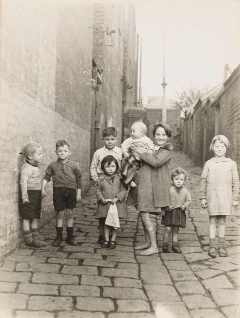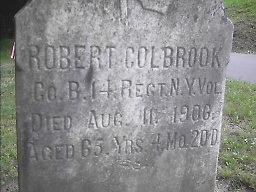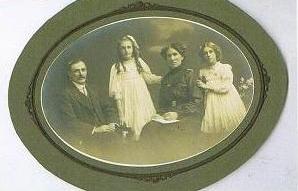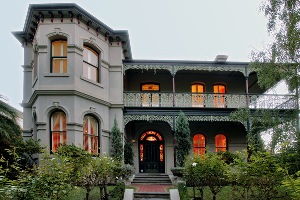Dear Donald,
job with research on Edwin.
The name Edwin has carried through three
generations of US Jerrems: My grandfather, father and
mine as a middle name.
| Remembering Edwin |
Ray Jerrems, Our Genealogist, Historian
Discovering Another Branch on the Family Tree
Introduction
This article is part of the “Remember Me” series.
It is appropriate for me to write about Edwin Jerrems
because we now have a reader of the Jerrems
Journal (Helen Mitchell) who is a great grand-
daughter of Edwin.
Sources of Information
My main sources of information come from Helen and
my own research.
Who was Edwin Jerrems?
Edwin was the eldest son of Robert Cane Jerrems,
the “founding father” of the Melbourne branch of the
Jerrems family, being a member of the Jerrems family
which migrated to Victoria in the 1850s and settled in
Richmond. His mother was Alice Rigg, who was born
in 1850 in County Cumberland, England (on the
Scottish border) and her Scottish parents were
Thomas and Agnes Rigg (nee Carter). Robert and
Alice were married in 1870.
Robert and Alice had 6 children, Edwin (1871-1929),
Edith Alice (1873-???), William George (1875-1937),
Gertrude Amelia (1877-1951), Henry Herbert (1881-
1928) and Alfred Robert Cain (1883-1940).
Edwin’s father Robert died in 1888 (when Edwin was
17) in Richmond and his mother Alice remarried in
1896, to James Alexander Newlands (b1829 in
Scotland, father William Newlands). James died in
Richmond in 1905, aged 76, leaving Alice a widow
once again. She died on 15th April 1919 at home in
Union Street, Richmond.
Edwin’s Marriage and Children
Briefly, Edwin married Matilda Amelia Thomas in
Richmond in 1896. They had 3 girls, Gertrude Amelia
Jerrems (b1898) and Victoria Alice Ruby Jerrems
(known as Ruby) b1900, who I will talk about later, and
Elizabeth Maud (b&d; 1899, aged 21 days).
They also had a son Edwin Thomas (b1896 in Carlton
West Hospital) who apparently died in the same year
(listed in Victorian BD&M; records as “Edwards
Thomas Jerrems”).
Edwin’s Wife Matilda
Matilda was born in Diamond Creek, a small town
situated in hilly country 25 km north west of Melbourne
CBD.
The busy and crowded suburb of Richmond would
have provided quite a contrast to Diamond Creek for
Matilda. Diamond Creek was a small village in the
1850s, with small rural holdings predominating in the
area, and a small gold mine nearby, but then it
received a large boost when the Diamond Creek Gold
Mine opened close to the village in 1863. Over the next
50 years the mine developed into a major local
industry, employing up to 200 men at its peak, going
down to 300 metres and drawing 5000 ounces of gold
a year.
A post office, Methodist church and a school were
established by the year after the mine opened. By
1893 in addition to the church and school there were 6
stores, a bank agency and a police station, with a
town population of 200 (the small town population
indicating that the town serviced a large rural
population, including people on farms and orchards).
Curiously for such an active town the railway was not
extended from Eltham to Hurstbridge via Diamond
Creek until 1912, before that (for instance in
1893), “public” transport was limited to 2 coaches per
day to Heidelberg, 15km to the south.
It is interesting to surmise how Matilda met Edwin and
how she adapted to city life in Richmond.
Edwin’s Occupation and Addresses
(1)1903 Electoral Roll 3 Berry Street, Richmond,
Painter (2) 1909 Electoral Roll 78 Bridge Road,
Richmond, Painter (3) 1914 Electoral Roll 2 Vere
Street, Richmond, Painter (4) 1919 Electoral Roll
same as for 1914.
Matilda’s addresses were the same, except for the
1909 Electoral Roll where she was listed at 243 Gore
Street, Fitzroy, 4 km from Richmond.
Richmond
The Melbourne suburb of Richmond played an
important role for the Jerrems family. I outlined the
history of Richmond in the February 2010 Journal. It
was a suburb of extremes, ranging from dingy
cobbled lanes to mansions (see photos).
When Edwin’s’s father Robert died there in 1888,
leaving Alice at the age of 38 to bring up 6 children
aged between 5 and 17 this would have placed Alice
in a very difficult financial position. Although Edwin
would have finished his training as a painter when his
father died in 1888, and would have been able to earn
an income, only his sister Edith Alice (b1873) would
have been old enough to work. As a result Edwin
would have been the major wage earner in the family,
a heavy responsibility for a teenager.
The effect on Edwin’s four other siblings of their
father’s early demise could have been that they had to
leave school as early as was legally allowed.
Two of Edwin’s brothers were also shown as painters
living in Richmond in the Electoral Rolls (Alfred,
painter in 1909, 1914, 1919), Henry (painter in 1903,
1909), so it is possible that Edwin trained two of his
younger brothers as painters and the 3 brothers
worked together. This would have relieved his mother
of the considerable responsibility of finding a trade for
those brothers.
It is in fact possible that Edwin’s third brother (William
George) was illiterate because his name was
spelled “Jerram” on his Army Enlistment Application.
His occupations (labourer and cleaner) were also
consistent with this.
Life as a House Painter
In his early days as a house painter Edwin would have
obtained sufficient work to make a comfortable living
in Richmond from painting new houses, and re-
painting existing houses in the well-to-do parts of
Richmond. However during the First World War the
building construction industry collapsed in Richmond
and the re-painting of existing houses would have
dropped off also. Perhaps he obtained some work
painting new factories constructed for wartime
production, but he may have had to search for other
work where he could find it.
House painting was not a healthy occupation in those
days. High-quality paints (as distinct from the
whitewash style of paints) typically contained over 80
per cent white lead (now known to be poisonous) with
the balance made up of linseed oil binder and
turpentine as the solvent. Many painters mixed their
own paint and added their own tints, and even if they
did not actually mix their own paint they were still
exposed to its toxic effects.
The Family Splits Up
Helen Mitchell’s information gained from her
grandmother Ruby is that Edwin and Matilda split up,
possibly soon after the family photograph was taken,
with Edwin taking Gertrude and Matilda (“Tilly”) taking
Ruby. This seems to have been an unusual
arrangement which would have caused anguish for
the girls, who were close in age. Later, Edwin and
Gertrude were better off financially, causing some
resentment on the part of Matilda and her daughter
Ruby.
Except that Edwin died in Prahran (a short distance
south of Richmond) in 1929 I do not know his
movements after 1919 (the last Electoral Roll in which
I have located him).
On the other hand, we know something of the
movements of Matilda and Ruby. At some stage they
moved to Ringwood (27 km east of Richmond) and
Ruby worked for Mr and Mrs Andrew Chung (who had
an orchard and market garden) as housekeeper. In a
romantic touch she finally married their son Herbert in
1923.
At that time Ringwood was a semi-rural area with a
large number of orchards. No doubt this reminded
Matilda very favourably of Diamond Creek, where she
was born. Although Ringwood was on the railway line
to Melbourne (which was electrified in 1923) it was
still a considerable distance between Ringwood and
Prahran by public transport and it appears that the
girls drifted apart.
Edwin’s Death, Grave
Edwin died in 1929 at the age of 58 when he was
living in Prahran, Melbourne. He died at Alfred
Hospital, Melbourne, the cause of death being shown
as Cerebral thrombosis, Cerebral haemorrhage and
Medullar failure. He was buried in Melbourne General
Cemetery (the grave has been reclaimed).
The gravesite was already well occupied by (a) Edwin
and Matilda’s infant son Edward Thomas Jerrems (b)
Robert Jerrems (buried shortly after Edward) (c)
Elizabeth Maude, his infant daughter and (d) Thomas
Rigg, his mother’s father.
More about Edwin’s Daughters
Gertrude Amelia Jerrems (b1898 in Richmond) died
in Heidelberg in 1978 aged 80. She married Charles
Edward Smith in 1920 and they had 2 children, Ruby
Alma Smith (1924-1994) and Charles Herbert Smith
(d1983). Ruby Alma Smith has numerous
descendants who I will not attempt to enumerate here.
Victoria Alice Ruby Jerrems (b1900 at Richmond) died
in 1987 and is buried in Box Hill Cemetery. As
mentioned earlier she married Herbert Michael Chung
in 1923. They had 5 children and a large number of
descendants (including Helen Mitchell) who I will not
attempt to enumerate here.
An interesting statistic is that the large number of
Edwin’s descendants (approximately 80) makes his
side of the Jerrems family by far the most prolific of
any of the Jerrems families.
The Photograph
This is a charming photo of Edwin, his wife Matilda,
and their daughters Gertrude Amelia Jerrems and
Victoria Alice Ruby Jerrems (known as Ruby). Based
on the fact that the girls look as though they are about
10 to 12 years old the photo would have been taken in
about 1910.
On this estimate Edwin would have been about 40
and his wife about 35. Edwin looks quite dapper with
his moustache and dark broad-lapelled dark suit and
Matilda is wearing an austere high necked dark dress.
The girls, with differing hair styles, are smart in their
white dresses. It is sad to see the girls, knowing that
they were to be split up later.
Conclusion
Thank you Helen for providing the photograph and
information about Edwin and his family, a photo
brings our stories alive.




